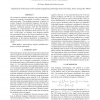Free Online Productivity Tools
i2Speak
i2Symbol
i2OCR
iTex2Img
iWeb2Print
iWeb2Shot
i2Type
iPdf2Split
iPdf2Merge
i2Bopomofo
i2Arabic
i2Style
i2Image
i2PDF
iLatex2Rtf
Sci2ools
97
Voted
ICASSP
2011
IEEE
2011
IEEE
Joint frequency spectral lag representation for cross-frequency modulation analysis in the brain
The concepts of modulation frequency along with modulation spectra are originally encountered in acoustics, speech and audio processing. The modulation spectrum, a function of acoustic frequency and modulation frequency, has been proposed and widely used in the speech processing community. However, modulation spectrum, much like time-frequency distribution is a representation of an individual signal and does not quantify the modulation effects between two signals. In this paper, we introduce cross frequency-spectral lag representation based on the Wigner distribution to represent the modulation relationships between two signals. The performance of the proposed distribution is illustrated for simulated signals as well as for electroencephalogram (EEG) signals.
| Added | 20 Aug 2011 |
| Updated | 20 Aug 2011 |
| Type | Journal |
| Year | 2011 |
| Where | ICASSP |
| Authors | Ali Yener Mutlu, Selin Aviyente |
Comments (0)

